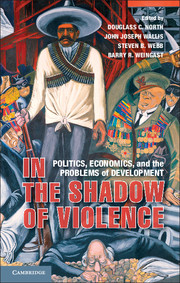Book contents
- Frontmatter
- Contents
- Contributors
- Acknowledgments
- One Limited Access Orders
- Two Bangladesh
- Three Fragile States, Elites, and Rents in the Democratic Republic of Congo (DRC)
- Four Seeking the Elusive Developmental Knife Edge
- Five Change and Continuity in a Limited Access Order
- Six India’s Vulnerable Maturity
- Seven Entrenched Insiders
- Eight From Limited Access to Open Access Order in Chile, Take Two
- Nine Transition from a Limited Access Order to an Open Access Order
- Ten Lessons
- Index
- References
Two - Bangladesh
Economic Growth in a Vulnerable LAO
Published online by Cambridge University Press: 05 December 2012
- Frontmatter
- Contents
- Contributors
- Acknowledgments
- One Limited Access Orders
- Two Bangladesh
- Three Fragile States, Elites, and Rents in the Democratic Republic of Congo (DRC)
- Four Seeking the Elusive Developmental Knife Edge
- Five Change and Continuity in a Limited Access Order
- Six India’s Vulnerable Maturity
- Seven Entrenched Insiders
- Eight From Limited Access to Open Access Order in Chile, Take Two
- Nine Transition from a Limited Access Order to an Open Access Order
- Ten Lessons
- Index
- References
Summary
Bangladesh was born out of two violent partitions, each caused by elites’ inability to agree about the distribution of rents. It has subsequently struggled to achieve political stability based on different mechanisms of rent distribution among its elites. In the midst of quite significant instability, its economic performance improved in the 1980s. Its experience therefore provides interesting case study material to examine and elaborate the LAO framework. The geographical territory of Bangladesh, then called East Pakistan, was first carved out of the eastern agrarian hinterland of Bengal in 1947 when British colonial rule ended. Unlike West Bengal, which remained in India and which was significantly industrialized at that time, East Bengal was almost entirely an agrarian economy growing rice and jute. In the 1960s, after very limited industrialization had been achieved, another set of violent confrontations between incumbent and emergent elites in Pakistan culminated in 1971 in the independence of East Pakistan, from that point forward known as Bangladesh. In more recent years, Bangladesh has emerged as a relatively high-growth developing country with a significant manufacturing base rooted in the garments and textile industries. But it has an apparently dysfunctional governance structure and political system with frequent political standoffs between the major political parties. We will examine the evolution of the LAO in Bangladesh as a transition between three variants of a basic LAO to a fourth and final version that has elements of maturity but is vulnerable and faces problems in enabling and sustaining sophisticated productive organizations. Indeed we will argue that there appears to be a tension between the capacity of LAOs in very poor countries to achieve sustainable political stability based on the accommodation of political organizations and their ability to assist the development of productive organizations.
- Type
- Chapter
- Information
- In the Shadow of ViolencePolitics, Economics, and the Problems of Development, pp. 24 - 69Publisher: Cambridge University PressPrint publication year: 2012
References
- 6
- Cited by



